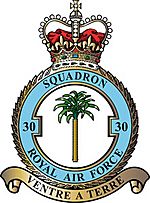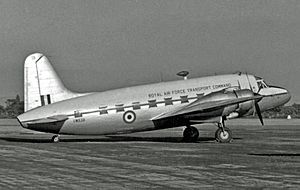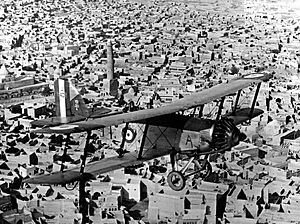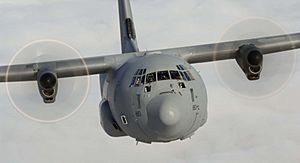No. 30 Squadron RAF facts for kids
Quick facts for kids No. 30 Squadron RAF |
|
|---|---|

Squadron badge
|
|
| Active | 24 March 1915 – 1 April 1918 (RFC) 1 April 1918 – 1 April 1946 (RAF) 1 November 1947 – 6 September 1967 10 June 1968 – 8 December 2016 28 September 2021 – present |
| Country | |
| Branch | |
| Type | Flying squadron |
| Role | Tactical air transport |
| Part of | No. 2 Group |
| Home station | RAF Brize Norton |
| Motto(s) | Ventre a terre (French for 'All out') |
| Insignia | |
| Squadron badge heraldry | A date palm tree, signifying the squadron's long service in the Middle East. Approved by King George VI in May 1938. |
Number 30 Squadron is a special flying unit of the Royal Air Force (RAF). They use large Airbus A400M Atlas transport planes. Their home base is RAF Brize Norton in Oxfordshire, England.
This squadron first started in 1915 as part of the Royal Flying Corps. They served during the First World War in places like Egypt and Mesopotamia (which is now Iraq). Their jobs included scouting, bombing, and even fighting other planes in the air. After the war, they stayed in Iraq. They helped deal with local uprisings against the British and later the Iraqi government.
Contents
History of No. 30 Squadron
First World War Service
In November 1914, the British Royal Flying Corps sent planes to Egypt. Their job was to protect the Suez Canal because war with the Turkish Empire was likely. The first planes were Farman Longhorn and Shorthorn biplanes. Soon, more planes like Royal Aircraft Factory B.E.2s arrived from India. This group of planes, based at Ismailia Airfield, officially became No. 30 Squadron on 24 March 1915.
On 24 August 1915, a small group of Australian planes, called the Mesopotamian Half Flight, joined 30 Squadron. They were in Mesopotamia (modern-day Iraq). This group, led by Captain Henry Petre, had been flying missions. They supported the Indian Army against Turkish forces in the Mesopotamian campaign.
More planes arrived in Mesopotamia on 26 August 1915. These were Martinsyde Scouts. Their engines often had problems in the hot and dusty conditions. Despite this, a part of the squadron helped the army move along the Tigris river. Their scouting flights helped British and Indian forces win the Battle of Es Sinn. They also helped capture Kut al-Imara in September 1915. In October 1915, the rest of the squadron moved to Mesopotamia. Another squadron, 14 Squadron, took their place in Egypt.
The squadron kept helping British forces as they moved towards Baghdad. But their advance stopped at the Battle of Ctesiphon in November 1915. A scouting mission before the battle saw that Turkish positions were much stronger. However, the plane was shot down, and the pilot was captured. Some historians believe if this information had reached the British commander, the attack might have been called off. After Ctesiphon, the British forces went back to Kut al-Imara. The Turkish Army followed, and Kut was surrounded starting 7 December 1915. Most of the squadron's people and some planes were trapped in the town.
With only one working B.E.2 plane, the squadron still helped scout for the forces trying to rescue the troops at Kut. More B.E.2s arrived in February 1916. The rescue attempt failed. In April 1916, the squadron, with eight B.E.2s, and other planes, did one of the first air supply missions. They dropped food and other items to the trapped soldiers. About 19,000 pounds (8,600 kg) of food were dropped. But it wasn't enough, and the British commander surrendered on 29 April.
The squadron grew stronger over the summer. By August, they had 13 B.E.2s. In September 1916, six Martinsyde Elephant scout planes joined them. The squadron supported a new British attack that began in December 1916. This led to the British capture of Baghdad on 11 March 1917. The squadron moved to Baghdad airfield that same day. In April 1917, German Halberstadt fighter planes arrived. They were much better than 30 Squadron's B.E.2s. To help, two Bristol Scout fighters joined the squadron. More powerful Spad VIIs were promised for later.
In August that year, 63 Squadron arrived in Mesopotamia. This meant 30 Squadron was no longer the only air support. In September, the promised Spads arrived. They replaced 30 Squadron's Bristol Scouts. From October, Royal Aircraft Factory R.E.8s started to replace the older BE.2s. By February 1918, all BE.2s were gone. In late 1917 and early 1918, the squadron received two Airco DH.4 bombers. However, both were lost by the end of January 1918.
1920s and 1930s Operations
In 1919, the squadron went to Iran. In April 1919, the squadron was reduced in size in Baghdad. But it was not completely stopped. In February 1920, it returned to full strength in Baghdad. It became an Army co-operation squadron using RE.8s. These were slowly replaced by Airco DH.9A light bombers. By early 1921, all planes were DH.9As. From June 1920, the squadron helped against an uprising in Iraq against British rule. In May–June 1921, 30 and 47 Squadron's DH.9As helped set up a land route between Cairo and Baghdad. They flew alongside vehicle convoys to create a clear path in the desert. From 21 June, these two squadrons also started flying air-mail along this route.
In early 1924, some planes from the squadron went to Kirkuk. They helped with operations against a revolt led by the Kurdish leader Sheikh Mahmud Barzanji. The city of Sulaymaniyah, where Mahmud was based, was bombed. Mahmud then moved into the mountains. The squadron was active again in the summers of 1925 and 1926. Mahmud's rebellion started again, and the squadron attacked villages held by the rebels. In early 1928, a group of 30 Squadron planes joined 'Akforce'. This group was formed to stop nomadic raiders from Saudi Arabia attacking Iraq and Kuwait. These operations continued until June.
In 1929, the squadron replaced its DH.9As with Westland Wapitis. In September 1930, Mahmud started another rebellion against the British and Iraqis. 30 Squadron helped the Iraqi Army fight the rebels. The fight against Mahmud lasted until May 1931, when Mahmud surrendered. Wapitis from 30 Squadron flew for 2204 hours between October 1930 and May 1931 during these operations. In March 1932, the Iraqi Army attacked a revolt by supporters of Ahmed Barzani in Southern Kurdistan. 30 Squadron first helped the Iraqi Army with scouting. But after one group was heavily attacked, the RAF launched air attacks against Barzani's forces. Barzani then crossed the border into Turkey. From April to August 1935, the squadron received Hawker Hardys. These were a special version of the Hawker Hart light bomber made for hot climates. 30 Squadron was the first to get them. In 1936, the squadron moved to the RAF's new base in Iraq, RAF Habbaniya. In 1938, they got modern Blenheim I monoplane bombers.
Second World War Actions
In August 1939, as war was about to begin, the squadron moved back to RAF Ismailia in Egypt. They flew escort missions in the Western Desert. They also defended Alexandria from enemy planes. In November 1940, they went to Greece. There, their Blenheims were used for both bombing and fighting. The first Blenheims arrived near Athens on 3 November. Some bombers were sent forward to Paramythia. The squadron's fighter Blenheims stayed in Athens to protect the city. In March 1941, the squadron was changed to be a fighter unit. On 5 April, five Blenheims went to Crete. Their jobs were to scout the sea, protect convoys, and fight at night. More of the squadron's Blenheims were sent to Maleme on Crete on 17 April.
By mid-May, German air attacks on Crete made it too dangerous for the squadron to operate from the island. On 15 May, the squadron's last three working Blenheims flew to Egypt. However, 229 officers and men from 30 and 33 Squadrons stayed at Maleme. On 20 May, the Germans launched an attack on the airfield with airborne troops. Many of these airmen, even though they had few weapons, helped defend Maleme. The survivors then tried to leave through Sfakia. Many were lost. After the losses in Greece and the Battle of Crete, the squadron was rebuilt. They became a fighter unit with Hawker Hurricanes. They defended Alexandria at night and patrolled to protect ships. Later, they moved to operations in the Western Desert.
When the situation in the Far East got worse, the squadron was ordered to help allied forces in Java. But by the time the squadron left Egypt, Java had already fallen. So, the aircraft carrier HMS Indomitable took the squadron to Ceylon. They arrived on 6 March 1942. They were just in time to help fight off the Japanese carrier attack on the island. This attack happened on 5 April 1942. 21 aircraft took off from their base at RAF Ratmalana while under heavy fire from Japanese planes. Seven of the squadron's Hurricanes were lost. Five pilots were killed or later died from their injuries. The squadron claimed to have shot down 14 Japanese planes. They also claimed six probably destroyed and five damaged. The island's total claims were 24 shot down, 7 probables, and 9 damaged. In reality, the Japanese lost seven aircraft, with 15 more damaged.
On 28 January 1944, the squadron left Ceylon for the Burma front. They flew escort missions for Dakota and C-46 transport planes over the Kaladan valley. In March, they also started attacking river boats at night. They moved to Comilla on 10 April 1944. On 25 May 1944, the squadron left the front lines. They went to Yelahanka near Bangalore to get new American Republic P-47 Thunderbolts. They returned to action in October. They escorted bombers and transports. They also attacked targets on the ground with guns, bombs, and napalm. They supported 15 Corps until the end of March. From Akyab, the squadron helped with Operation Dracula. This was an Anglo-Indian landing at Rangoon on 1 May. After Rangoon was captured, there was a break in fighting. The squadron was taken out of the front line to get ready for Operation Zipper. This was a planned British invasion of Malaya. But Japan surrendered on 15 August, so the squadron was not needed for the landings.
After the War

After Japan surrendered, the squadron stayed in India. Their Thunderbolts were replaced by Hawker Tempest F Mk 2s in March 1946. No. 30 Squadron gave up its planes on 1 December 1946. It was then officially stopped on 1 April 1947 at Agra.
On 24 November 1947, the squadron started again at RAF Oakington, Cambridgeshire. It became a transport unit within the Royal Air Force Transport Command. They flew Dakota planes on many humanitarian flights during the Berlin Airlift. They got new Vickers Valetta planes in December 1950. From April 1957 to September 1967, they flew the larger four-engine Blackburn Beverley. From November 1959, 30 Squadron operated from RAF Eastleigh in Kenya. They then moved to RAF Muharraq in October 1964.
Hercules and Atlas Aircraft (1968 – present)
The Squadron temporarily stopped in September 1967. But it quickly started again at RAF Fairford in June 1968. They were equipped with turbine-propeller powered Lockheed Hercules transport planes. This kept the unit in its transport role. The squadron moved to RAF Lyneham in September 1971.
In 2008, 'A' flight of the squadron was based at RAF Al Udeid. They used the Hercules C.4 aircraft there.
The squadron flew its last Hercules flight on 8 December 2016. It then took on a management role. It reformed again on 28 September 2021. Now, it is the second main squadron to operate the Airbus A400M Atlas aircraft.
Aircraft Used by No. 30 Squadron
- Farman Longhorn 1915
- Farman Shorthorn 1915–1916
- Voisin LAS 1915–1916
- Henry Farman F27 1915
- Caudron G.3 1915
- Royal Aircraft Factory B.E.2 1915–1917
- Royal Aircraft Factory R.E.8 1917–19
- Airco D.H.9 1921–1929
- Westland Wapiti 1929–1935
- Hawker Hardy 1935–1938
- Bristol Blenheim 1938–1941
- Hawker Hurricane 1941–1944
- Republic P-47 Thunderbolt 1944–1946
- Hawker Tempest F2 1946
- Douglas Dakota 1947–1950
- Vickers Valetta 1950–1957
- Blackburn Beverley 1957–1967
- Lockheed C-130 Hercules 1968–2016
- Airbus A400M Atlas 2021 – present
Memorials
-
Front panel of No. 30 Squadron RAF at the National Memorial Arboretum
There is a Royal Air Force (RAF) memorial in Crete. It remembers the airmen of 30 and 33 Squadrons. They died during the Battle of Crete. The memorial is located (35°31′31″N 23°49′43″E / 35.525363°N 23.828619°E) behind a hedge. It is between Maleme and Tavronitis. It looks over the (35°31′36″N 23°49′32″E / 35.526625°N 23.825604°E) Iron Bridge across the Tavronitis River. It is also near the end of the Maleme Airport runway.
Another memorial was opened at the National Memorial Arboretum in Staffordshire. This happened in September 2008.
Battle Honours
Battle honours are special awards given to military units. They show important battles or campaigns where the unit fought bravely. Those marked with an asterisk can be displayed on the Squadron Standard (a special flag).
- Egypt (1915)*
- Mesopotamia (1915–1918)*
- Iraq (1919–1920)
- North West Persia (1920)
- Kurdistan (1922–1924)
- Iraq (1923–1925)
- Iraq (1928–1929)
- Kurdistan (1930–1931)
- Northern Kurdistan (1932)
- Egypt and Libya (1940–1942)*
- Greece (1940–1941)*
- Mediterranean (1940–1941)*
- Ceylon (April 1942)*
- Arakan (1944)*
- Burma (1944–1945)*
- South Atlantic (1982)
- Gulf (1991)
- Afghanistan (2001–2014)
- Iraq (2003–2011)
- Libya (2011)







